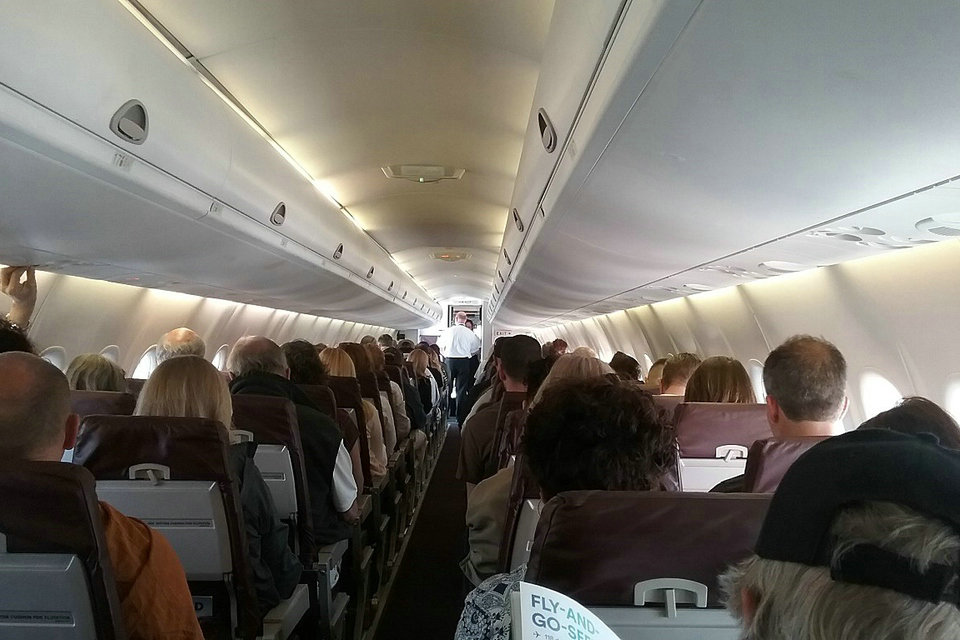Air rage


Air rage is disruptive or violent behavior on the part of passengers and crew of aircraft, especially during flight. Air rage generally covers both behavior of a passenger that is likely caused by physiological or psychological stresses associated with air travel, and when a passenger becomes unruly, angry, or violent on an aircraft during a flight. Excessive consumption of alcohol by the passengers is often a cause.
Stopping and ejecting the offender is often not a practical option, as landing would inconvenience the flight schedule of the aircraft and the other passengers more than the misbehaving person himself. However, unlike large ships, there is insufficient room on board to hold the offender in an isolated area until arrival. Therefore, diversions or unscheduled stops do occur because of air rage.
Examples of behavior that threatens flight safety include failure to follow safety regulations or behaving in a way that gives suspicion of a threat to flight safety.
An airline passenger’s uncontrolled anger is usually expressed in aggressive or violent behavior in the passenger compartment, but air rage can have serious implications, especially if the offender decides to interfere with the aircraft’s navigation or flight controls. Generally, such passengers are not at risk of committing terrorist acts, but since the September 11 attacks, such incidents have been taken more seriously due to increased awareness of terrorism.
History
The first case of air rage was recorded in 1947 on a flight from Havana to Miami, when a drunk man assaulted another passenger and a flight attendant. Another early documented case involved a flight in Alaska in 1950.
At the time, applicable jurisdiction was unclear, so offenders often escaped punishment. It wasn’t until the 1963 Tokyo Convention that laws of the country where the aircraft is registered were agreed to take precedence.
Air rage events have increased markedly since the September 11 attacks. No definite explanation for that trend has been established; possible explanations include heightened anxiety for one’s safety and irritation with invasive security.
Causes
The most common cause of a passenger or crew member acting unruly is from intoxication. The availability of alcoholic beverages on airlines and at airports enables passengers to drink excessively before and during flights. Flight attendants have the ability to keep track of how many drinks are served to passengers while on board an aircraft, but have no way of knowing how many are consumed prior to boarding. Despite urban legends, however, the effects of alcohol are not increased at altitude.
Other causes include the use of drugs (prescription or illegal).
Sometimes, sober passengers are disruptive by failing to obey laws and rules that must be observed or arguing with flight attendants.
Stressful situations, such as jet lag, flight delays, or other difficult or annoying passengers or crew members in one’s vicinity, can lead passengers and crew members to an increased likelihood of becoming agitated and air rage.
Traits
Air rage generally covers both behavior of a passenger or passengers on the aircraft or more generally speaking at the airport:
Undue anger.
Gratuitous violence.
Unruliness.
Obnoxiousness
Threatening flight safety.
Failure to follow safety regulations.
Behaving in a way that gives suspicion of a threat to flight safety.
Claiming to have a bomb on the flight or falsely saying they are a terrorist with malignant intent.
Temper tantrums.
Disruptive behaviour.
Threatening crew members and other passengers.
Other related behavior that may interfere with the comfort of cabin crew or passengers include smoking on board the flight, viewing pornographic materials, performing sex acts (“mile high” club) in the aircraft cabin, making undue sexual advances towards other people, performing sex acts in the lavatory, the inappropriate groping and touching of crew members, loud or drunken behaviors, spitting, swearing, and wearing clothing that is inappropriate or offensive.
Handling air rage
Extremely unruly passengers or crew members who must be restrained are restrained using a variety of methods. Some airlines carry flexcuffs for this purpose. Others use seatbelts, adhesive tape, neckties, shoe laces, or whatever is available on the aircraft. While the United States does not allow passengers to actually be confined to the seat or any other part of the aircraft, and only allows their individual body parts to be restrained, other countries, such as Iceland, do allow tying an unruly passenger to the seat.
Sometimes a flight must be diverted to allow an aircraft to dispose itself of the offender as soon as possible.
Consequences
In the United States, passengers who disrupt the duties of a flight crew member can face fines up to $25,000 and sometimes lengthy prison sentences. In addition, the airline can choose to ban the problem passenger from any future flights.
In Australia, the Civil Aviation Safety Authority reserves the right to use stun guns to subdue unruly passengers.
In Canada the Pilot-in-Command (Captain) of the aircraft is designated as a Peace Officer under the Criminal Code and as such, have the same powers of arrest as a Police Officer. The Pilot-in-Command is authorized to enforce all sections of the Criminal Code and all Acts of Parliament while the aircraft is in flight.
Source from Wikipedia